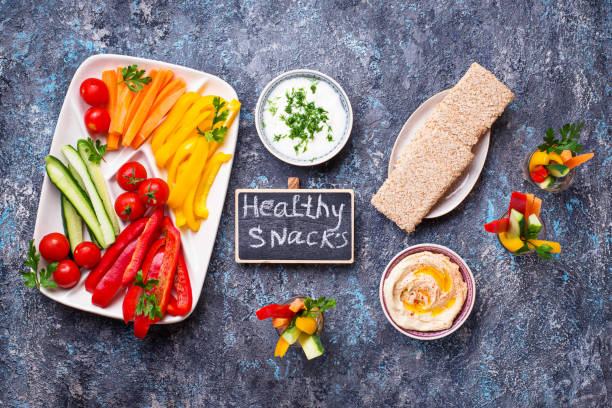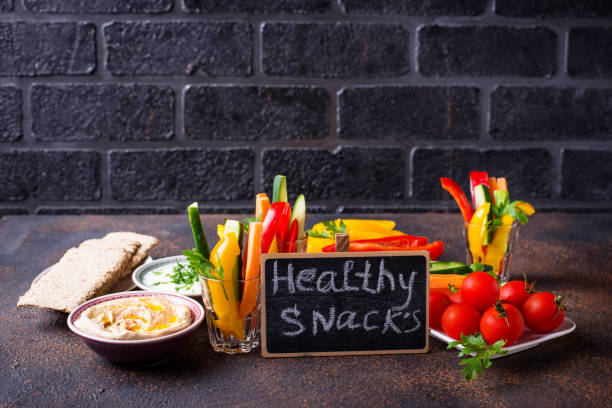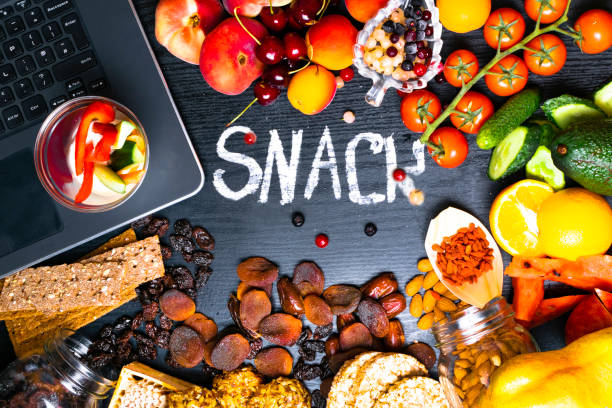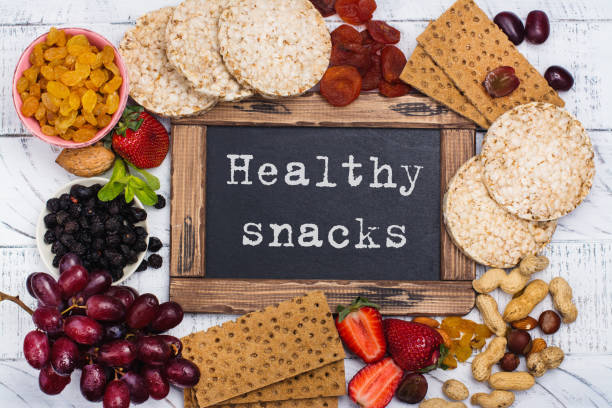Why Smart Snacking Matters When You Have Diabetes
Snacks can help you manage hunger and steady your blood sugar. The trick is picking the right foods, in the right portions, at the right time. You want snacks with fiber, protein, and healthy fats. These nutrients slow digestion. They help prevent big spikes and sudden drops. The goal is a steady curve, not a roller coaster. The CDC also teaches that counting carbs can help you plan snacks that fit your day. One “carb choice” is about 15 grams of carbs. That’s a handy rule when you portion snack foods. (CDC)
You may also see the term “glycemic index” (GI). It’s a scale that shows how fast a carb food raises blood sugar. Lower-GI foods raise it more slowly. That often means fewer spikes. Harvard Health has a clear guide if you want to learn more. (Harvard Health)
Snack Strategy 101: Keep It Simple and Balanced
Aim for snacks that mix fiber, protein, and healthy fat. Think “produce + protein.” Or “whole grain + protein.” This quick formula helps you build a better snack in seconds. The American Diabetes Association (ADA) also suggests using snacks to add more veggies, fruit, whole grains, and good fats to your day. (American Diabetes Association, American Diabetes Association)
What a “Carb Choice” Looks Like
- 1 small piece of fruit (about 15 g carbs)
- 6 small crackers (about 15 g carbs)
- ¼ cup granola (about 15 g carbs)
Use these to size your snack and pair with protein. (CDC)

Best Diabetes-Friendly Snacks (Easy, Tasty, and Quick)
Below are snack ideas you can grab fast or prep in minutes. Use the portions as a guide. Adjust based on your plan, your blood sugar, and your goals. For many people, 1 carb choice (about 15 g carbs) per snack works well. Pair with protein or healthy fat to feel full. (CDC)
Produce + Protein Pairings (Low-Glycemic Snack Ideas)
- Apple slices + peanut butter. Try 1 small apple with 1 tablespoon peanut butter. The fiber and fat slow the rise in blood sugar. (Harvard Health)
- Carrot sticks + hummus. Go for 1 cup carrots and 2 tablespoons hummus. Crunchy, filling, and simple. (American Diabetes Association)
- Cucumber coins + tuna salad. Use light mayo or Greek yogurt for a protein boost.
- Cherry tomatoes + mozzarella pearls. Add a bit of olive oil for healthy fat.
- Berries + cottage cheese. Start with ½ cup berries and ½ cup low-fat cottage cheese.
High-Protein Snack Ideas (Great for Fullness)
Protein helps control hunger between meals. Studies show that higher-protein choices can support satiety and weight goals. That can help you stick to your plan. (PMC)
- Hard-boiled egg + a few whole-grain crackers.
- Plain Greek yogurt (¾ cup) + cinnamon. Add a few berries if you like.
- Edamame (¾ cup). Steam and sprinkle with a pinch of salt.
- Turkey roll-ups. Turkey slices wrapped around avocado or cucumber.
- Canned salmon on cucumber slices. Omega-3s plus protein in one bite.
Crunchy, Salty, and Still Smart
- Air-popped popcorn. 3 cups is about 15 g carbs. Add a dash of paprika or garlic powder. (Verywell Health)
- Roasted chickpeas. ¼ cup. Crisp, fiber-rich, and great for meal prep.
- Nuts (almonds, walnuts, pistachios). About 1 ounce (a small handful). Nuts have healthy fats and can support heart health. (The Sun)
- Olives + cheese cube or two. Rich in healthy fats; pair with a few veggie sticks.
- Seaweed snacks + edamame. Light, savory, and easy to pack.
Sweet Tooth, Meet Better Choices
- Chia pudding. 2 tablespoons chia seeds soaked in unsweetened milk. Top with berries.
- Banana “nice cream.” Blend frozen banana slices with a splash of milk; keep to a small ½-cup serving. ADA’s snack hub has more low-sugar treat ideas. (diabetesfoodhub.org)
- Dark chocolate (70%+). A small square with a few almonds can hit the spot.
- Apple “nachos.” Thin apple slices drizzled with a teaspoon of nut butter and a few pumpkin seeds.
Smarter Carbs: Choose Lower-GI, Higher-Fiber Options
Not all carbs act the same. Whole foods with fiber, like beans, lentils, oats, and many fruits, tend to have a lower GI. They digest slower. That can help reduce spikes. Use the GI concept to compare choices and pick the gentler option when possible. (The Nutrition Source)
Examples of lower-GI snack bases:
- Steel-cut oats (small portion) with Greek yogurt
- Whole-grain crackers with tuna or hummus
- Lentil cups or roasted lentils
- Apples, berries, pears, or oranges with nuts or cheese (Harvard Health)
Portion Control for Diabetics: How Much Is “Just Right”?
Portion size matters as much as food type. Even healthy foods can raise blood sugar if portions are large. Use measuring cups at home to learn your “visual cues.” Pre-portion snacks into small containers or bags. ADA’s snack guide stresses watching your portions, especially with nuts, dried fruit, and crackers. (American Diabetes Association)
Quick portion cues:
- Nuts: 1 small handful (about 1 oz)
- Hummus: 2 tablespoons
- Cheese: 1–2 small cubes (about 1 oz)
- Crackers: Check the label; aim for about 15 g carbs per snack serving
- Fruit: 1 small piece or ½ cup cut fruit (about 15 g carbs) (CDC)
How to Build a Snack That Balances Blood Sugar
Follow this easy three-step method:
Step 1: Pick Your Carb (About 15 g)
- Fruit, whole-grain crackers, popcorn, or a small oatmeal cup. The CDC lists common “carb choices” to guide you. (CDC)
Step 2: Add Protein or Healthy Fat
- Egg, Greek yogurt, cottage cheese, tuna, chicken, tofu, nuts, or nut butter. Protein and fat help you feel full and slow the rise in blood sugar. (PMC)
Step 3: Add Color and Fiber
- Non-starchy veggies like carrots, cucumbers, bell peppers, tomatoes, or leafy greens. ADA encourages loading up on non-starchy vegetables for volume and nutrients. (American Diabetes Association)
Example plates:
- 6 whole-grain crackers + 1 hard-boiled egg + cucumber slices
- ½ cup berries + ½ cup cottage cheese + a few walnut halves
- 3 cups popcorn + 1 string cheese + cherry tomatoes

Smart Snacking Schedule: When to Eat
Your ideal timing depends on your meds, meals, and activity. Some people do best with one planned snack between meals. Others prefer a small evening snack to help prevent overnight lows. Keep a log. Note what you ate, your portion, and your blood sugar before and after. Over time, you will spot patterns that work for you. For individualized targets, use a plan from your care team and ADA’s healthy eating guidance. (American Diabetes Association)
Store-Bought Snacks: What to Look For on the Label
When you grab a packaged snack, read the Nutrition Facts and the ingredient list. You are hunting for fiber, protein, and simple ingredients.
Label checklist:
- Carbs per serving: Aim for ~15 g for a single snack. Watch sugar alcohols if you are sensitive. (CDC)
- Fiber: 3+ grams is great for fullness.
- Protein: 7–15 grams is a good target for most snacks. (PMC)
- Added sugars: Keep them low.
- Sodium: Aim for less than 200 mg per snack, if possible.
Better-for-you packaged picks:
- Roasted chickpeas or lentil crisps
- Lightly salted nuts or nut packs
- Plain Greek yogurt cups
- Tuna pouches
- Whole-grain crispbreads
Budget-Friendly Snack Prep (Save Money, Eat Well)
Healthy snacks do not need to cost much. Try these simple prep ideas on a budget:
- Buy in bulk. Portion nuts, popcorn kernels, and chickpeas into snack bags.
- Use freezer fruit. It’s often cheaper and just as nutritious.
- Roast your own beans. A can of chickpeas makes several snack portions.
- Make a big batch. Cook extra chicken, turkey, or tofu for roll-ups all week.
- Try affordable stars like almonds. They’re shelf-stable, portable, and nutrient-dense. (The Sun)
Diabetes-Friendly Snack Ideas by Situation
When You Need Something in 60 Seconds
- String cheese + grape tomatoes
- Greek yogurt cup + cinnamon
- Small apple + 1 tablespoon peanut butter
- Handful of almonds + a few berries
Before a Workout (Light Fuel)
- 1 small banana + a few peanuts
- ½ whole-grain wrap with turkey
- 1 cup berries + ½ cup yogurt
After a Workout (Protein-Forward)
- Cottage cheese + pineapple chunks (small portion)
- Tuna pouch + whole-grain crackers
- Edamame bowl + sea salt
Late-Night Snack (Keep It Gentle)
- ½ cup ricotta + sliced strawberries
- 3 cups popcorn + string cheese
- Cucumber “boats” with hummus
Low-Glycemic Snack Swaps You Can Make Today
Upgrade your usual snacks with simple swaps:
- Potato chips → Roasted chickpeas (more fiber and protein)
- Sugary granola bar → Greek yogurt + nuts (lower sugar, more protein)
- White crackers → Whole-grain crackers (more fiber, lower GI)
- Candy → Dark chocolate square + almonds (smaller portion, healthy fats)
- Juice → Whole fruit + water (fiber wins)
Harvard’s GI guidance can help you pick swaps that steady blood sugar. (Harvard Health)
Real-World Portions: Visual Cues You Can Trust
- 1 ounce nuts: small handful that fits in your cupped palm
- 2 tablespoons hummus or nut butter: about a ping-pong ball
- 1 ounce cheese: two small dice
- 3 cups popcorn: about two big fists
- ½ cup berries or cottage cheese: half a tennis ball
If you like structure, the CDC’s carb counting tools are great for planning snack sizes around 15 g carbs. (CDC)
How to Personalize Snacks to Your Plan
Everyone’s body is different. Your meds, activity, and goals shape your snack plan. Work with your healthcare team to set targets. The ADA recommends eating styles you can keep up long term. If a snack fits your culture, taste, and routine, you’ll stick with it. That is success. (American Diabetes Association)
Tips to personalize:
- Track how you feel 1–2 hours after a snack.
- Note energy, cravings, and blood sugar.
- Adjust portion size first, then ingredients.
- Keep 2–3 “go-to” snacks ready at all times.
Snack Inspiration from Trusted Sources
Want more ideas you can use tonight? Try these snack lists and recipes from high-authority sources:
- American Diabetes Association: Healthy snack tips and recipes you can filter by prep time and carbs. (American Diabetes Association, diabetesfoodhub.org)
- CDC: Carb counting and lists of common foods with carb amounts. Perfect for label reading and planning snacks. (CDC)
- Harvard Health: Clear explainers on glycemic index and choosing better carbs. (Harvard Health)

Troubleshooting Common Snack Problems
“I’m still hungry after I snack.”
Add more protein or fiber. Try Greek yogurt, cottage cheese, eggs, or edamame. Research shows protein boosts fullness. (PMC)
“My blood sugar spikes after certain snacks.”
Check portions. Choose lower-GI carbs, and pair them with protein or fat. Use the CDC’s 15 g carb guide as your anchor. (CDC)
“I crave sweets at night.”
Plan a small, satisfying snack with protein and fiber. Try chia pudding or yogurt with berries. Keep portions modest. ADA’s snack recipes can help. (diabetesfoodhub.org)
“Healthy snacks are too expensive.”
Buy basics like beans, popcorn kernels, frozen berries, and bulk nuts. Pre-portion them. Almonds are a budget-friendly option with big nutrition. (The Sun)
Quick Shopping List for Smart Snacking
Protein: Eggs, Greek yogurt, cottage cheese, tuna pouches, chicken breast, tofu, edamame
Whole-grain bases: Crispbreads, whole-grain crackers, oats, popcorn kernels
Produce: Apples, berries, pears, oranges, carrots, cucumbers, bell peppers, cherry tomatoes
Healthy fats: Almonds, walnuts, pistachios, olives, avocado, olive oil
Pantry extras: Chickpeas (canned), lentils, chia seeds, cinnamon, garlic powder
Conclusion: Snack With Confidence
Smart snacking is simple once you have a plan. Choose whole foods. Watch portions. Pair carbs with protein and healthy fat. Use tools from ADA, CDC, and Harvard to guide your choices and lower the guesswork. You’ll feel more in control, with steadier energy and fewer cravings. (American Diabetes Association, CDC, Harvard Health)
Let’s make this practical: What is your biggest snacking challenge—time, cravings, cost, or confusion about portions? Drop a comment with your top two snacks and your toughest moment of the day.



